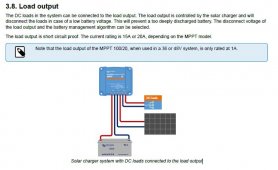jakew009
New Member
- Joined
- Jun 27, 2021
- Messages
- 25
View attachment 105672
God, I suck at making charts. Anyhow, repeat for however many batteries and panels you have. Nice thing about having separate MPPTS is each panel gets it's own special loving and redundancy.. and it eliminates all those dc to dc chargers and diodes you were using. Maybe use a few smaller panels, so each Victron can have it's own.. one panel per mppt/battery. The small Victrons are cheap as dirt for their build quality. Other than voltage losses from running smaller strings (which would be very minimal), you don't lose much on multiple conversions this way.
This also keeps you from having any single point of failure.. other than the busbar. And the only thing touched by your "technicians" is the disconnect and the connections to the one single battery behind it.
How are you preventing a 100% battery feeding a load of current to a 5% battery?
Or does the Victron Load output already function as an ideal diode and prevent back feeding?



